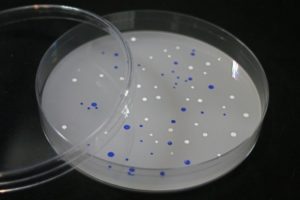
PCR amplification with a proofreading polymerase, like Pfu DNA polymerase, will leave you with a blunt end. However, another thermostable DNA polymerase, like Taq DNA Polymerase, adds a single nucleotide base to the 3’ end of the DNA fragment, usually an adenine, creating an “A” overhang. This “A” overhang can create difficulties when cloning the fragment is your end goal. You might consider creating a blunt end with Klenow or adding restriction sites to the ends of your PCR fragment by designing them in your primers. But why go through all those extra steps, when that “A” overhang allows efficient cloning of these fragments into T-Vectors such as the pGEM®-T Vectors? Fewer steps? Who can argue with that?
Traditionally, efficient cloning of blunt-ended fragments into a vector required several steps. The vector needed to be dephosphorylated with either Calf Intestinal Alkaline Phosphatase (CIAP). Dephosphorylating the vector keeps it from self-ligating; it also means the vector needs to be purified before you can proceed with the ligation step. To improve efficiency, the ligation buffer could be modified by adding polyethylene glycol (to crowd the molecules together) and a low amount of ATP. High concentrations of T4 DNA Ligase and lots and lots of your precious insert were also needed.
Adding restriction sites to the ends of your primers requires careful planning when designing primers. Not all restriction enzymes efficiently cleave at the ends of DNA fragments. Some restriction enzymes require extra bases outside the recognition site, adding further expense to the PCR primers as well as risk of priming to unrelated sequences in your template DNA. There is some useful information about cutting with restriction sites close to the end of linear fragments in the Restriction Enzyme Resource Guide.
Tailing your blunt-ended insert with Taq DNA Polymerase and cloning it into a T-Vector eliminates a lot of headaches. No dephosphorylation of your vector means no need to purify it. It is also unlikely that you will have to optimize the ligation buffer. And even though the recommended molar ratio of insert to vector falls anywhere between 8:1 and 1:8, you will most likely end up using less insert than you would have with blunt-end cloning. And no worries about restriction digest compatibility or restriction site placement in the primers.
Ready to Get Started? Set Up the Following Reaction:
- 1–4µl purified blunt-ended DNA fragment (from PCR, restriction enzyme digestion, or even sheared and blunted genomic DNA)
- 2µl of 5X GoTaq® G2 Flexi or any other GoTaq Reaction Buffer (Colorless or Green)
- 2µl of 1mM dATP (0.2mM final concentration)
- 2µl GoTaq® G2 Flexi any other GoTaq® DNA Polymerase
(5u/µl) - 0.6µl of 25mM MgCl2 (1.5mM final concentration)*
- Nuclease-free water to a final volume of 10µl
Incubate at 70°C for 15–30 minutes in a water bath or thermal cycler.
*If using a Taq polymerase buffer already containing MgCl2, omit this step.

The A-tailed fragments can be cloned directly into the pGEM®-T, or the pGEM®-T easy vectors without further purification. The pGEM®-T Easy Vector System allows you to remove your insert with a single BstZI, EcoRI or NotI digest.
Don’t forget, Promega Technical Support is available to help with any questions along the way.
Related Posts
Latest posts by Leah Cronan (see all)
- Mass Spec for Glycosylation Analysis of SARS-CoV-2 Proteins Implicated in Host-Cell Entry - November 10, 2020
- Proteomics from a Different Point of View: Introducing ProAlanase, the Newest Mass-Spec Grade Protease from Promega - August 7, 2020
- Go fISH! Using in situ Hybridization to Search for Expression of a SARS-CoV-2 Viral Entry Protein - July 10, 2020
